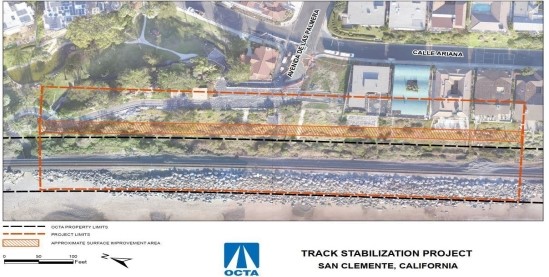Vote clears way for CEO Darrell E. Johnson and OCTA staff to work with a contractor to immediately begin stabilization efforts, expected to take 30 to 45 days; CTC approves $6 million in funding
ORANGE – The Orange County Transportation Authority Board of Directors at a special meeting today unanimously declared an emergency need for railroad track stabilization in southern San Clemente.
The Board vote clears the way for CEO Darrell E. Johnson and OCTA staff to take the quick and necessary actions needed to secure a contractor and move forward with work to stabilize the gradually sliding hillside next to the rail line, which would allow for safely restoring passenger service through the area.
In two additional significant actions on Monday, Caltrans declared the situation a state transportation emergency, and the California Transportation Commission held an unprecedented special meeting to consider emergency funding. That meeting resulted in the CTC allocating $6 million from the State Transportation Improvement Program in funding for the track stabilization.
“Our first priority, of course, is the safety and well-being of all rail passengers and crew members who travel through this area,” said OCTA Chairman Mark A. Murphy, also the Mayor of Orange. “This quick action by our Board and the state will allow us to move forward with a more effective interim solution to prevent the tracks from moving and to safely restore rail service through this vital corridor.”
The track work, which is still being finalized, will involve driving large metal anchors into about 700 feet of the slope adjacent to the railroad track to prevent it from pushing the track further toward the coast. Ground anchors are typically effective in preventing soil movement by installing the steel cables diagonally into the bedrock beneath the slope.
A timeline for completing the work is still being determined but clearing vegetation and staging for the emergency work is anticipated to begin this week with installation of ground anchors beginning as soon as possible.
The stabilization work will likely take 30 to 45 days to complete, allowing for passenger rail service to resume.
Until the emergency work on the slope begins, additional rip rap is being placed with the goal of further securing the existing revetment.
OCTA continues to work with state and federal officials to secure all necessary funding to pay for the emergency construction, estimated at $12 million overall.
“We greatly appreciate Caltrans and the California Transportation Commission taking decisive action on this and working with us so quickly on advancing a solution,” said OCTA CEO Darrell E. Johnson.
“We all understand the urgency of this issue and are working around the clock with all of our partners, including at Metrolink, Amtrak Pacific Surfliner. the state and our elected leaders to complete this work as efficiently as possible, always prioritizing safety,” CEO Johnson added.
OCTA owns the railroad right-of-way between Fullerton and the border with San Diego County and Metrolink and Amtrak operate passenger rail service along the railroad through South Orange County.
In September 2021, heavy rain and storm surge caused movement along the track adjacent to the Cyprus Shore Homeowners Association in southern San Clemente, near Avenida de las Palmera and Calle Ariana. At that time, Metrolink suspended passenger rail service through the area for about three weeks and stabilized the track movement by placing more than 18,000 tons of large boulders, known as rip rap, along the coastal side of the track.

While that emergency work stabilized the track for several months, geologists and engineers monitoring the area determined after additional storm surge last month that the adjacent slope was moving again and the track was moving .01 inches to .04 inches per day. It became evident additional mitigation measures were necessary, including to stabilize the hillside east of the track.
On Sept. 30, Metrolink and Amtrak, out of an abundance of caution, halted all passenger train service through the area until more stabilization efforts could take place. BNSF, which operates freight rail through the area, is continuing to help bring stabilization materials to the site.
In addition to the immediate repair work, OCTA continues to review long-term options for protecting the rail line in this area and throughout the coastal region and will seek input from the public and all stakeholders as it continues to study the issue.
OCTA’s priority now is to work with all partners to move forward with slope stabilization as soon as possible to ensure safety for all passengers who travel through the area.
For updates, visit www.octa.net.